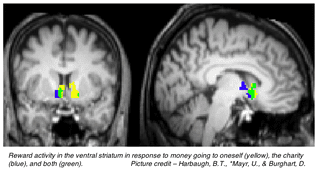You don't choose donors, they choose you
Choice is an important concept in fundraising – donors love it.
When we offer choice through simple techniques such as shopping lists in appeals or more complex devices such as post-recruitment questionnaires that give donors control over the communications they receive, we build loyalty and generate more gifts.
There is a piece of research that helps explain why this occurs. Harbaugh, Mayer and Burghart of the University of Oregon undertook an experiment where they gave 19 young women $100 each and then confronted them with a selection of different scenarios...
- The money would be taken away with no explanation.
- The money would be taken away and given to a local charity.
- They were given the choice of keeping the money or donating it to charity.
- They could keep the money, and an extra gift would be given to charity.
All this happened whilst they were in an MRI scanner – a machine that mapped their brain activity whilst the scenarios were being considered.
The researchers found they could divide their subjects into two different types depending on brain activity. They defined these two groups as egoists andaltruists depending on whether their brain responded more to keeping the money for themselves or more to donating the money to charity.
Those whose scans showed a positive response to money going to the charity rather than to themselves were about twice as likely to give money voluntarily.
People obviously didn't like money being taken away with no reason, but if the money was given to the charity, the parts of the brain that became activated were those that respond to basic rewards such as sweets, food or positive social contact.
When the decision to give to charity was completely voluntary, these reward areas produced increased amounts of activity.
In short, active giving produced an extra neural benefit over passive giving. Something that both economists and fundraisers might describe as a "warm glow".
Sadly when giving was voluntary, the charity got 10% less than when a percentage of it was"taxed".
You don't need an MRI scanner in your fundraising department to appreciate what this means – if a donor feels coerced into giving, the rewards they feel are minimal and the relationship is off to a rotten start.
We only have to look at attrition rates associated with different types of recruitment activity to see what happens when there is a sniff of coercion in recruitment – cancellations go crazy.
Face to face, cold telephone and even TV have very high attrition rates compared to the emotionally cooler recruitment techniques such as direct mail and press ads.
One of the ways of managing the high attrition rates delivered by some recruitment channels is by demonstrating just how important the donor is to your work immediately after recruitment. And then giving them complete control over the relationship. If we do this, we help activate that "warm glow", which is just what the altruists are looking for. As a direct result, we stem attrition.
Bluefrog's head of creative, Aline Reed has recently posted a piece on her blog, Bluefrog Creative, about how we are tackling Face to Face attrition for Care International. It's early days, but by offering donors insight into the impact they are having and giving them control over the relationship, we are seeing some rather pleasing figures. You can see this work by clicking here.
As Aline explains, we aim to publish the outcome of this test along with some other research at a major presentation in London on the 13th of November. As usual with Bluefrog research, there will be no charge for attendance or our report. Email me at[email protected], if you'd like additional information or to be added to the guest list.
In the meantime, If you'd like to brush up on where you are likely to find things like the striatum (where all the fun happens), I suggest you watch this short video to get you up to speed on all things brain related.
Tags In
The Essentials

Crack the Code to Regular Giving: Insights, Strategies, and a Special Giveaway!

‘Tis Halloween. Keep to the light and beware the Four Fundraisers of the Apocalypse!

Why do people give? The Donor Participation Project with Louis Diez.

A guide to fundraising on the back of a postcard

What does the latest research tell us about the state of fundraising?







